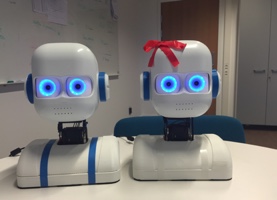LUCS Robotics Group
Epi – A Humanoid Robot

Epi is a humanoid robot developed by LUCS Robotics Group. It was designed to be used in experiments in developmental robotics and has proportions to give a childlike impression while still being decidedly robotic.
The robot head has two degrees of freedom in the neck and each eye can independently move laterally. There is a camera in each eye to make stereo vision possible.
The arms are designed to resemble those of a human. Each arm has five degrees of freedom, three in the shoulder, one in the elbow and one in the wrist.
The hands have four movable fingers and a stationary thumb. A force distribution mechanism inside the hand connect a single servo to the movable fingers and makes sure the hand closes around an object regardless of its shape. The rigid parts of the hands are 3D-printed in HIPS while the flexible parts, including the joints and the tendons, are made from polyurethane rubber.
The control system for Epi is based on neurophysiological data and is implemented using the Ikaros system. Most of the sensory and motor processing is done at 40 Hz to allow smooth movements.

There is also a smaller version of Epi consisting of a head on a torso. In addition to the motions possible in the earlier model of Epi, the irises of the eyes can change color and the pupils can dilate and contract. There also a grid of LEDs that resembles a mouth that can be animated by changing colour and intensity.
There are currently five versions of Epi in the robotics lab, one of which is mounted on a mobile platform.
The Epi platform is open source and software can be downloaded at:
• https://github.com/ikaros-project
and models for 3D printing at:
• https://github.com/birgerjohansson/Epi.
